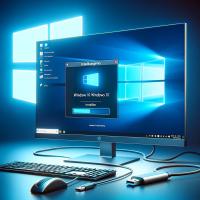How to Install Windows 10, Quick Installation and Download

Introduction
Installing Windows 10 is a process that allows you to upgrade from an earlier version of Windows or perform a clean installation on a new or existing computer. This guide provides comprehensive steps to install Windows 10, ensuring a smooth transition to Microsoft’s popular operating system.
Preparing for Installation
Before installing Windows 10, ensure your PC meets the minimum system requirements and back up your data to avoid any loss.
Minimum System Requirements:
- Processor: 1 gigahertz (GHz) or faster processor or SoC
- RAM: 1 gigabyte (GB) for 32-bit or 2 GB for 64-bit
- Hard disk space: 16 GB for 32-bit OS or 20 GB for 64-bit OS
- Graphics card: DirectX 9 or later with WDDM 1.0 driver
- Display: 800x600
Data Backup:
- Use an external drive or cloud storage to secure your files.
- Consider creating a full system image for complete restoration.
Obtaining Windows 10
You can obtain Windows 10 via download or physical media. Microsoft offers several methods to download or purchase the installation media.
Options to Obtain Windows 10:
- Download from Microsoft: Visit the Microsoft website to purchase and download the Windows 10 installation file.
- Purchase a USB Drive: Buy a Windows 10 installation USB from Microsoft or a retail store.
- Use the Media Creation Tool: Download this tool from Microsoft’s website to create your own installation media using a USB drive or DVD.
Installing Windows 10
You can upgrade your current system or perform a clean installation. Each method has specific steps.
Upgrading to Windows 10:
- Run the Windows 10 Setup: Start the upgrade by opening the installation media and running the setup file.
- Choose 'Upgrade this PC now': Select this option to keep your files, settings, and applications. The tool will download and install Windows 10 over your current system.
Clean Installation:
- Boot from the Installation Media: Insert the USB or DVD and reboot your computer. Enter the BIOS/UEFI settings to set the boot device to the USB/DVD.
- Install Windows 10: Follow the on-screen prompts to format your drive (optional) and install Windows 10. You’ll need to select your language, time, and keyboard preferences, and enter your product key.
- Custom Installation: Choose ‘Custom: Install Windows only (advanced)’ to perform a clean installation. This will delete all your files on the installation drive.
Post-Installation Setup
After installing Windows 10, there are a few steps to configure your system and restore your data.
Initial Setup:
- Follow the on-screen instructions to configure your settings such as privacy settings, network connectivity, and user account setup.
Post-Installation Tasks:
- Install Device Drivers: Ensure all your hardware is functioning correctly by installing the latest drivers.
- Check for Updates: Run Windows Update to download the latest patches and security updates.
- Restore Your Data: If you performed a clean installation, now is the time to restore your data from the backup.
Conclusion
Installing Windows 10 can significantly improve your PC’s performance and security, especially if you are upgrading from an older version. Whether you choose to upgrade or perform a clean installation, following these steps will help ensure a successful installation of Windows 10.







